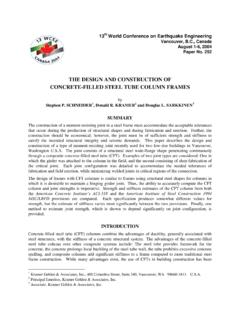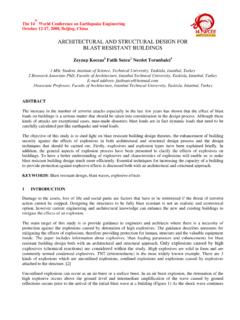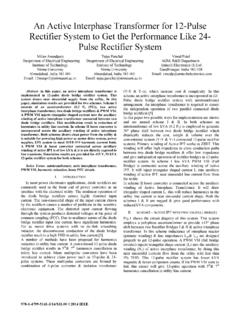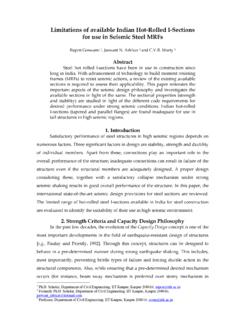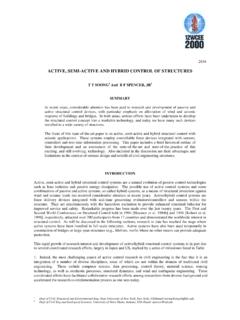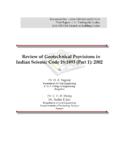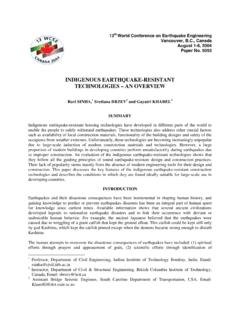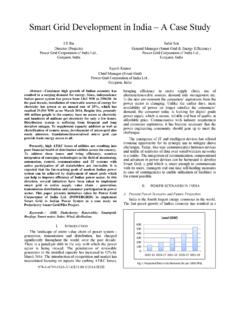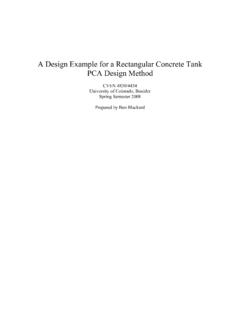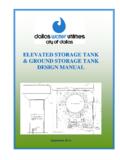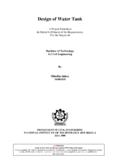Transcription of A Design Procedure for Concrete Rectangular Liquid Storage ...
1 A Design Procedure for Concrete Rectangular Liquid Storage Tanks Using Generalized SDOF System J. Z. Chen, CH2M HILL Canada, Toronto, Ontario, Canada M. R. Kianoush Ryerson University, Toronto, Ontario, Canada SUMMARY: In this paper, a Design Procedure based on the structural model using the generalized single degree of freedom (SDOF) system is proposed for Concrete Rectangular Liquid containing structures (LCS). The proposed model considers the effect of flexibility of tank wall on hydrodynamic pressures and uses the consistent mass approach in dynamic analysis. The contribution of higher modes to the dynamic response of LCS is included in the proposed model.
2 The square root of sum of square (SRSS) method is proposed for the combination of the first two modes. Three tanks classified as shallow, medium and tall are used for verification. The response spectra for three suites of time history representing low, moderate and high earthquake zones are used for generalized SDOF system. The results based on the lumped mass, and the distributed mass approach, as well as those obtained using the sequential method and the generalized SDOF systems are compared. It is concluded that the results based on the generalized SDOF system have good agreement with those used the distributed mass and the sequential analysis models. The proposed Design Procedure using the generalized SDOF system can be simply used in seismic Design of LCS.
3 Keywords: Reinforced Concrete ; Liquid containing; Rectangular tank; seismic; dynamic analysis 1. INTRODUCTION Liquid containing structures (LCS) as part of environmental engineering facilities are primarily used for water and sewage treatment plants and other industrial wastes. Normally, they are constructed of reinforced Concrete in the form of Rectangular or circular configurations. Currently there are few codes and standards available for seismic Design of LCS in North America. In almost all of codes and standards, Housner s model (Housner, 1963) has been adopted for dynamic analysis of LCS. This model approximates the effect of hydrodynamic pressure for a two fold-symmetric-fluid container subjected to horizontal acceleration as shown in Figure 1.
4 The hydrodynamic pressures induced by earthquakes are separated into two parts of impulsive and convective components which are approximated by the lumped added masses. The added mass in terms of impulsive pressure is assumed rigidly connected to the tank wall and the added mass in terms of convective pressure is assumed connected to the tank wall using flexible springs to simulate the effect of sloshing motion. In this model, the boundary condition in the calculation of hydrodynamic pressures is treated as rigid. Yang (1976) and Veletsos (1984) studied the effect of the wall flexibility on the magnitude and distribution of hydrodynamic pressures and associated tank forces.
5 It was found that for tanks with realistic flexibility, the impulsive forces are considerably higher than those in rigid wall. Haroun (1984) presented a very detailed method of analysis in the typical system of loadings for Rectangular tanks. However, the formula of hydrodynamic pressures only considered the rigid wall condition. Park et al. (1990) used the boundary and finite elements to study the dynamic behaviour of Rectangular tanks. Subsequently, Kim et al., (1996) presented an analytical method for calculation of hydrodynamic pressures based on three-dimensional analysis of tanks. It is worth noting that only few studies on the seismic response of flexible Rectangular tanks are currently available and their results are not in a form suitable for direct use in Design as mentioned in Eurocode 8 (CEN, 2006).
6 (a) Fluid motion in tank (b) Dynamic model for rigid wall tank Figure 1 Housner s model Chen and Kianoush (2005) developed a Procedure referred to as the sequential method for computing hydrodynamic pressures based on a two-dimensional model for Rectangular tanks in which the effect of flexibility of tank wall was taken into consideration. The sequential method is a coupling technique in which the two fields of fluid and structure are coupled by applying results from the first analysis as loads or boundary conditions for the second analysis. Later Kianoush et al. (2006) and Ghaemian et al. (2005) applied the staggered method to solve the coupled Liquid Storage tank problems in three-dimensional space.
7 The staggered method is a partitioned solution Procedure that can be organized in terms of sequential execution of a single-field analyzer. The scheme of staggered method is to find the displacement and hydrodynamic pressure at the end of the time increment i + 1, given the displacement and hydrodynamic pressure at time i. Compared to Housner s model, these results show that in most cases the lumped mass approach leads to overly conservative results. Also, the effect of flexibility of tank wall on hydrodynamic pressure should be considered in dynamic analysis. Chen and Kianoush (2009) proposed a generalized single degree of freedom (SDOF) system for dynamic analysis of LCS.
8 The consistent mass approach and the effect of flexibility of tank wall on hydrodynamic pressures were considered. The prescribed vibration shape functions representing the mode shapes for the cantilever wall boundary condition were validated. The effective heights for Liquid containing system and the effect of higher modes on dynamic response of LCS were studied. Chen and Kianoush (2010) further investigated the effects of height of Liquid and width of tank on dynamic response of LCS. The Liquid level varied from the empty HL=0 to the full tank HL=HW. Also, instead of using the ratio of width of tank to the Liquid height, Lx/HL, the ratio Lx/HW and the ratio of height of Liquid to the wall height, HL/HW were used as a characteristic parameter for tank size and Liquid level in tank respectively in the study of dynamic response of LCS.
9 The added mass of Liquid due to impulsive hydrodynamic pressure and the effective height in relationship with the ratios of Lx/HW and HL/HW were presented which can be used in seismic Design of LCS. As part of continuous research effort to apply the generalized SDOF system in dynamic analysis of LCS, a Design Procedure is proposed in this paper. The proposed structural model can overcome the deficiencies in the current Design codes and standards. The theories and procedures for dynamic analysis of LCS are summarized. Three tanks classified as shallow, medium and tall are used for verification. The response spectra for three suites of time history representing low, moderate and high earthquake zones are used for generalized SDOF system.
10 The results based on the lumped mass, and the distributed mass approach, as well as those obtained using the sequential method and the generalized SDOF systems are compared. 2. GENERALIZED SDOF SYSTEM FOR DYNAMIC ANALYSIS OF LCS Analysis Model The generalized SDOF system is a simplified system using only one variable for dynamic analysis of distributed mass and stiffness characteristics for a predetermined mode shape. Normally, the amplitude of vibration is the only variable or degree of freedom (DOF) used in dynamic analysis and varies with time. In this paper, the generalized SDOF system is applied in the dynamic analysis of Concrete Rectangular LCS subjected to earthquakes.
